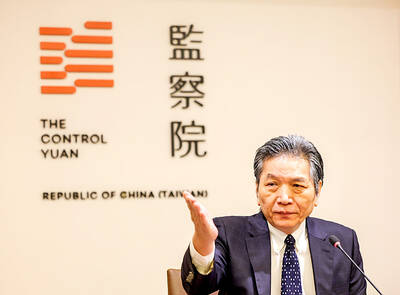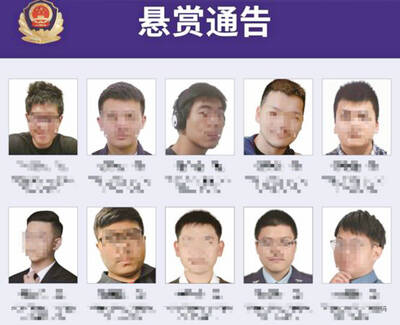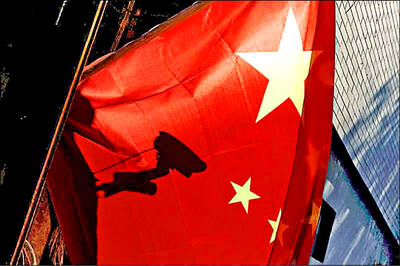All seven stories in a China Reports insert accompanying the local English-language China Post newspaper yesterday were stories originally published in Chinese Communist Party (CCP)-run publications, but nowhere were the sources mentioned, an omission that could violate domestic laws on product placement.
The eight-page insert, dated April 8, and which purports to be the Volume 2, No. 12 issue of the Reports, contains seven human interest stories, all of which were taken from the People’s Daily, Xinhua news agency and the China Daily in recent months. All three are owned by the CCP and well known for their pro-CCP editorial stance.
Readers informed the Taipei Times that the insert has appeared sporadically in recent months, including the past three Fridays.
All seven articles were published without a byline, date of original publication or the name of the original publication, and nowhere is the insert identified as originating from an outside source, which could lead readers to believe that the material comes from the China Post staff.
When contacted by the Taipei Times, the editorial department at the Post said they were in no position to comment on the matter since the entire insert was produced and sent to them from Hong Kong.
Asked if any China Post staff had control over content in the insert, the person contacted said: “I don’t think so.”
Other China Post staff members that were contacted seemed unaware of the insert.
Facing a storm of protest about the government’s placement of material in media late last year, the Executive Yuan on Dec. 30 proposed a series of non-binding measures to address the problem.
However, during a Cabinet meeting, Government Information Office (GIO) Minister Johnny Chiang (江啟臣) said the GIO was not a supervisory organ for print media because the Publishing Act (出版法) was annulled in 1999.
About two weeks later, the legislature passed a binding resolution requiring the Executive Yuan to pursue legal amendments to limit the government’s use of embedded marketing and that all government policy campaigns should be clearly marked as advertisements.
An amendment to the Budget Act (預算法) was also passed, which banned embedded marketing by government agencies at all levels, as well as state-funded or state-run enterprises. However, at no time was embedded marketing by foreign governments discussed.
Government agencies are allowed to utilize paid advertising to promote policies either by publishing newspaper ads, placing supplemental sections in newspapers or commissioning electronic media to produce programs. However, they are required to have the agency’s name shown in the proper context and the material must be clearly identified as product placement.
Asked for comment yesterday, Department of Planning Director Hsu Hsiao-li (徐孝利), who oversees the GIO’s regulatory agency in charge of cross-strait affairs, said his office would ask for explanations from the China Post regarding the China Report inserts.
If necessary, the department would invite experts to a meeting to determine the content’s conformity with the Guidelines for Permitting Mainland Publications, Movies, Video, Radio and Television Programs to Enter, or be Issued, Sold, Produced, Broadcast, Exhibited, and Copied in the Taiwan Region (大陸地區出版品電影片錄影節目廣播電視節目進入台灣地區或在台灣地區發行銷售製作播映展覽觀摩許可辦法), Hsu said.
One concern of the GIO, which did not know about the insert before being approached by the Taipei Times, was whether the insert was a form of entry for Chinese print media into Taiwan, disguised in a manner that allowed it to avoid being reviewed by the Taiwanese government, Hsu said.
The guidelines stipulate that Chinese productions, including newspapers, newswire stories, magazines, books and audio books, are not allowed to enter Taiwan without government permission.
The Chinese bi-weekly magazine Duzhe is the only Chinese-produced print media allowed for sale in the Taiwanese market. Its first issue, published in traditional Chinese characters, appeared in January.
Hsu said another concern about the China Reports insert was the possibility that it served as an -advertorial promoting China, adding that to a certain extent, the stories in the China Reports insert relating to business and cultural activities in China lay in a gray area between news and product placement.
Although exchanges of stories between media are within the scope of freedom of speech, there nevertheless is a need for government to ensure the material is appropriate, Hsu said
This development comes amid a global drive by China to increase its media presence.
Late last year, a print and Web-based advertorial section called China Watch, containing articles from the China Daily, was added to the Washington Post. However, the insert identifies the source of the material as coming from the China Daily, has a byline and the masthead states that this is a paid supplement to the Washington Post.

‘ABUSE OF POWER’: Lee Chun-yi allegedly used a Control Yuan vehicle to transport his dog to a pet grooming salon and take his wife to restaurants, media reports said Control Yuan Secretary-General Lee Chun-yi (李俊俋) resigned on Sunday night, admitting that he had misused a government vehicle, as reported by the media. Control Yuan Vice President Lee Hung-chun (李鴻鈞) yesterday apologized to the public over the issue. The watchdog body would follow up on similar accusations made by the Chinese Nationalist Party (KMT) and would investigate the alleged misuse of government vehicles by three other Control Yuan members: Su Li-chiung (蘇麗瓊), Lin Yu-jung (林郁容) and Wang Jung-chang (王榮璋), Lee Hung-chun said. Lee Chun-yi in a statement apologized for using a Control Yuan vehicle to transport his dog to a

Taiwan yesterday denied Chinese allegations that its military was behind a cyberattack on a technology company in Guangzhou, after city authorities issued warrants for 20 suspects. The Guangzhou Municipal Public Security Bureau earlier yesterday issued warrants for 20 people it identified as members of the Information, Communications and Electronic Force Command (ICEFCOM). The bureau alleged they were behind a May 20 cyberattack targeting the backend system of a self-service facility at the company. “ICEFCOM, under Taiwan’s ruling Democratic Progressive Party, directed the illegal attack,” the warrant says. The bureau placed a bounty of 10,000 yuan (US$1,392) on each of the 20 people named in

The High Court yesterday found a New Taipei City woman guilty of charges related to helping Beijing secure surrender agreements from military service members. Lee Huei-hsin (李慧馨) was sentenced to six years and eight months in prison for breaching the National Security Act (國家安全法), making illegal compacts with government employees and bribery, the court said. The verdict is final. Lee, the manager of a temple in the city’s Lujhou District (蘆洲), was accused of arranging for eight service members to make surrender pledges to the Chinese People’s Liberation Army in exchange for money, the court said. The pledges, which required them to provide identification

INDO-PACIFIC REGION: Royal Navy ships exercise the right of freedom of navigation, including in the Taiwan Strait and South China Sea, the UK’s Tony Radakin told a summit Freedom of navigation in the Indo-Pacific region is as important as it is in the English Channel, British Chief of the Defence Staff Admiral Tony Radakin said at a summit in Singapore on Saturday. The remark came as the British Royal Navy’s flagship aircraft carrier, the HMS Prince of Wales, is on an eight-month deployment to the Indo-Pacific region as head of an international carrier strike group. “Upholding the UN Convention on the Law of the Sea, and with it, the principles of the freedom of navigation, in this part of the world matters to us just as it matters in the